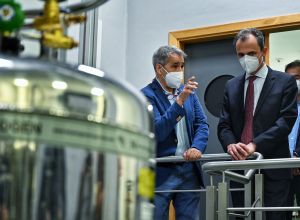- La nueva infraestructura del CNB-CSIC permite obtener imágenes tridimensionales tanto de estructuras biológicas complejas como de moléculas sencillas a nivel atómico
- Las instalaciones cuentan con un criomicroscopio electrónico y otros dos de barrido y confocal
El ministro de Ciencia e Innovación, Pedro Duque, ha inaugurado hoy las nuevas instalaciones de criomicroscopía del Centro Nacional de Biotecnología del Consejo Superior de Investigaciones Científicas (CNB-CSIC), las más avanzadas de España. La infraestructura consiste en un criomicroscopio electrónico de transmisión, otro de barrido y otro confocal. La criomicroscopia electrónica es una técnica de vanguardia que permite observar las células y sus componentes con un nivel de detalle sin precedentes: por ejemplo, capta la entrada de un virus en una célula.
A la presentación han acudido junto al ministro el secretario general de Investigación, Rafael Rodrigo; el vicepresidente de Investigación Científica y Técnica del CSIC, Jesús Marco; el director del CNB-CSIC, Mario Mellado, y el investigador José María Valpuesta, director científico del servicio de criomicroscopía.
“La criomicroscopía electrónica permite mostrar en tres dimensiones tanto estructuras biológicas complejas como moléculas más sencillas en un estado lo más parecido al fisiológico, incluso a resolución atómica”, explica Valpuesta.
“El servicio de criomicroscopía electrónica del CSIC ofrece un apoyo extra a los investigadores, ofertando desde la puesta a punto de la técnica experimental adecuada para las muestras hasta un procesamiento de las imágenes obtenidas realizado en paralelo por el Centro de Procesamiento de Imágenes (I2PC), dirigido por José María Carazo y Carlos Óscar S. Sorzano, perteneciente a la infraestructura europea Instruct-ERIC y también localizado en el CNB-CSIC”, añade Valpuesta.
La ampliación de las instalaciones de criomicroscopía del CNB-CSIC ha sido posible gracias a una inversión de 8 millones de euros apoyada por el Ministerio de Ciencia e Innovación y con fondos estructurales FEDER de la Unión Europea, a través del proyecto CRIOMECORR. “El CSIC apuesta por incorporar en sus laboratorios instrumentación de última generación para que sus grupos de investigación sean competitivos a nivel internacional, y atraigan a los mejores jóvenes científicos” señala Jesús Marco.
Una técnica para observar las células
La criomicroscopía electrónica, que permitió a los investigadores Jacques Dubochet, Joachim Frank y Richard Henderson ganar el premio Nobel de Química en 2017, es una técnica clave para la investigación en biología estructural. Consiste en combinar el proceso de vitrificar (congelación ultrarrápida a temperaturas de -180 °C) las muestras biológicas con su observación y toma de datos en un criomicroscopio electrónico. Esta técnica permite observar las células y sus componentes con un nivel de detalle sin precedentes.
“La criomicroscopía electrónica permite resolver la estructura tridimensional, en un estado lo más parecido al fisiológico, tanto de estructuras biológicas complejas como de moléculas más sencillas, incluso a resolución atómica”, añade Valpuesta.
Dentro de este servicio destaca el microscopio JEOL CryoARM 300, el primero de su tipo instalado en España. Se trata del criomicroscopio electrónico más avanzado a nivel nacional que desde 2020 está disponible para investigadores españoles y europeos.
Más de 25 años de experiencia
El CSIC ha desarrollado desde el CNB-CSIC una trayectoria en microscopía electrónica que cuenta con más de un cuarto de siglo de experiencia. Inaugurado en 2016, el primer servicio de criomicroscopía electrónica contaba con dos criomicroscopios electrónicos para conocer las estructuras de distintos virus, proteínas y complejos celulares implicados en patologías como el alzhéimer y el cáncer. En 2019, aproximadamente 150 grupos de investigación españoles y 26 europeos tuvieron acceso a unas instalaciones que vieron incrementadas sus infraestructuras y su potencial gracias al Proyecto CRIOMECORR.
Los nuevos criomicroscopios de barrido y fotónicos se suman al criomicroscopio electrónico JEOL CryoAM300, para realizar microscopía correlativa, una técnica que permite complementar el análisis estructural de muestras biológicas complejas e incluso eventos biológicos, como la división celular o mitosis.
CSIC Comunicación






